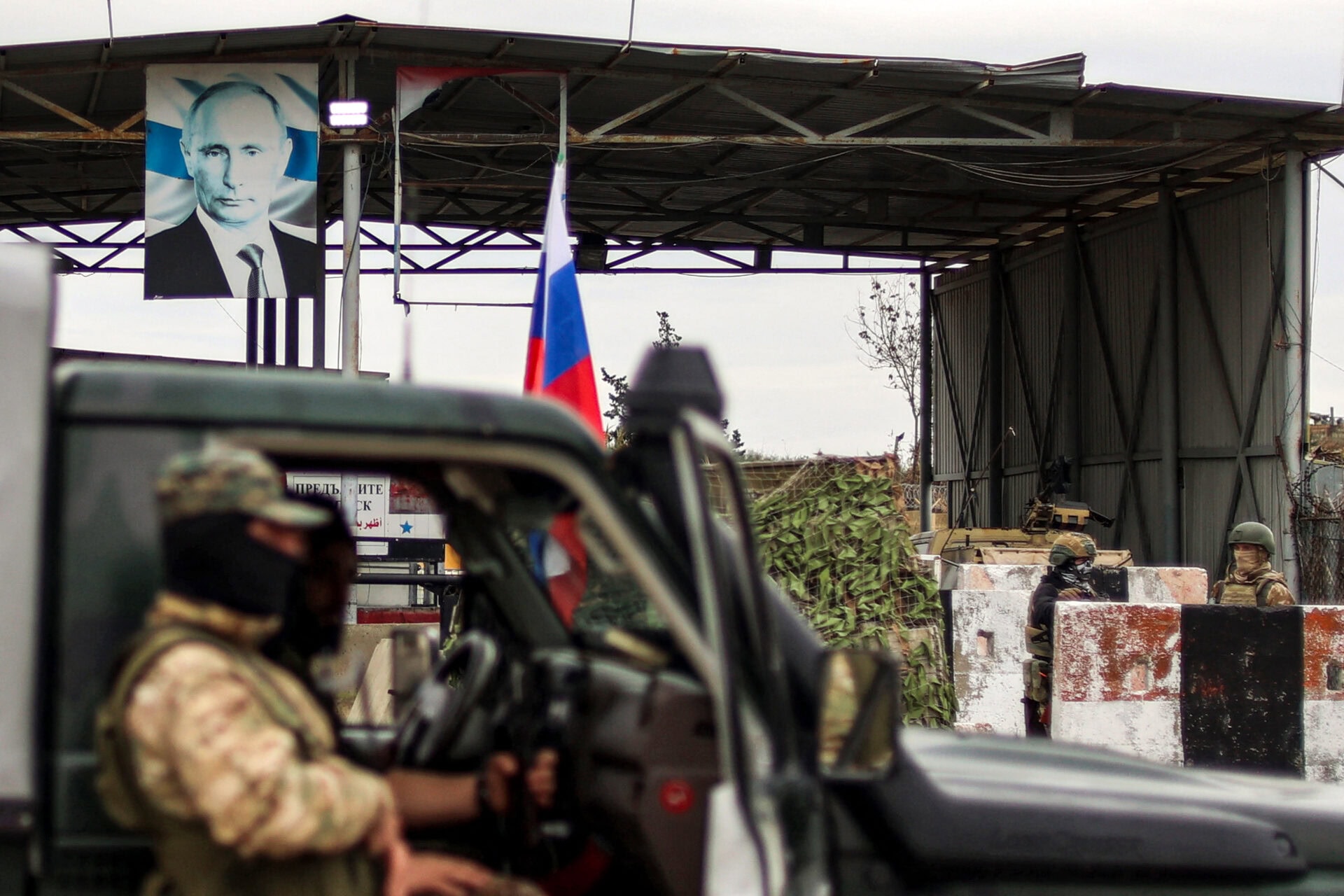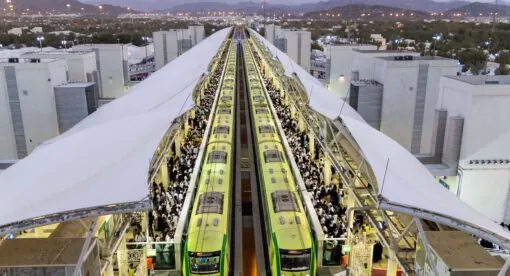Russia’s legacy of supporting Syrian President Bashar al Assad’s regime could either lead to its eviction from Syria or its voluntary withdrawal, considering the fluctuating Syrian security landscape and the recently opened door for U.S.-Syria engagement. If the interim Syrian government vetoes a permanent Russian presence, Moscow sees Libya as workable replacement. In north and central Africa, the U.S. and European powers have faced dwindling influence while Russia has swooped into the vacuum. As the Middle East has experienced intensified escalation between Iran and Israel, Russia may seek to exploit international distraction and fulfil its goal to expand influence in Libya and Africa.
A year ago, the Kremlin would not have viewed Syria as the weak link in Russia’s geopolitical ambitions. Syria was the central bastion of Russia’s foreign outposts. Russian military flights stopped at Khmeimim, the Russian-operated airbase in Latakia, to refuel, carrying loot, goods, and fighters perpetuating Russia’s neo-colonialist efforts across Africa. Russia’s naval base at Tartus has been an essential strategic position and the only point on the Mediterranean where Russia could both service its vessels and deter NATO’s presence. Meanwhile, Russia played a major role in the Syrian Civil War. Its drone strikes and private military contractors helped regime forces regain large swathes of territory before solidifying the front line.
This situation changed dramatically in late November 2024 when a constellation of opposition groups, led by Sunni Islamist group Hay’at Tahrir al-Sham, toppled Assad’s regime. Russia’s loss of a key ally in Assad embarrassed it internationally and could lead to the loss of crucial military installations.
Syria is still the best option for Russia as the linchpin for its activities in Africa. Its eastern location generally meant less NATO oversight and access to the Bosphorus Strait, a key maritime chokepoint and deterrent to Türkiye. It was a crucial maintenance and repair hub for the Russian navy, with the port able to both accommodate four medium-sized vessels, including submarines, and replenish warships via helicopter. Without Tartus, Russian vessels must travel to Novorossiysk without refueling. With the last submarine departing Tartus on Jan. 2, some analysts have gone as far as to call the base irreplaceable.
With the potential loss of Syria, Russia likely will prioritize the preservation of its activities in Africa by pivoting to Libya to springboard fighters and units into “partner” countries. Because this pivot involves significant adjustments and financial investment, Russian supply lines will be strained, and its influence in Africa will be shaken. Therefore, it remains in the United States’ interest to apply pressure for Russia’s withdrawal from Syria to destabilize Russia’s African network.
Russian Influence in Africa
Khmeimim’s 3½-hour flight time from Moscow makes it a perfect refueling stop for Russian forces headed to Africa. From Syria, it takes a further 5½ hours to Bangui in the Central African Republic, where the former Wagner Group, now rebranded as Africa Corps, acts like a neo-colonial entity. Africa Corps promotes the Kremlin’s interests in Northern and Central Africa through a “survival package” to leaders: providing military capacity and political disinformation operations in exchange for favorable economic contracts and embedded Russian influence. Africa Corps fighters comprise personal bodyguard units and protect Russian investments in extractive sectors, besides fighting insurgents and opposition forces. Syria’s location as the gateway of influence extends Russia’s reach into Africa. Russia’s partner countries in Africa with active front lines, such as Mali and the Central African Republic, will face increased pressure on supply lines, equipment, and unit rotations until an alternative logistical hub to Syria is secured. This is especially crucial in countries where Russian fighters provide leaders’ personal security, or during the run-up to elections, such as in Mali.
Putin also faces a crisis of Russian influence in North and Central Africa with the fall of Assad. His armed mercenaries and Africa Corps-linked entities are the chief component promoting and protecting Russian interests in Africa. Partner governments like Niger and the Central African Republic will be concerned about whether Russia will withdraw support in a crisis, and the overthrow of Assad may be seen as a warning sign. Russian-aligned governments could seek a new security partner, particularly with continual Russian setbacks in Mali and stagnation in Sudan. The Wagner Group particularly struggled to combat jihadist militants in Mali and experienced a humiliating defeat in late 2019, suffering significant fatalities against an Islamist insurgency led by Al-Shabaab. These underlying cracks make this a crucial moment to disrupt Russian activities amid Moscow’s growing influence across the Sahel. The Wagner Group particularly struggled to combat jihadist militants in Mali and experienced a humiliating defeat in late 2019 in Mozambique, suffering significant fatalities against an Islamist insurgency led by Al-Shabaab. These underlying cracks make this a crucial moment to disrupt Russian activities amid Moscow’s growing influence across the Sahel.
A recent wave of military coups in the Sahel, fueled by anti-colonial sentiments, expelled French, U.S., and U.N. forces. Russia and China have stepped into the vacuum with respective security forces and investment. The region has considerable natural resources such as oil, lithium, uranium, and natural gas, but it is also strategically located between North and sub-Saharan Africa. The head of AFRICOM, Gen. Michael Langley, recently called Burkina Faso the “global epicenter of terrorism,” where growing jihadist insurgent elements are ramping up their ability to attack the United States. Indeed, the Sahel now accounts for over half of global terrorism deaths. Groups include the al-Qaeda affiliate Jama’at Nusrat al-Islam wal Muslimin, Islamic State in the Greater Sahara, Islamic State in West Africa Province, and Boko Haram.
Contemptuous of any western influence, Niger’s ruling junta revoked the military accords allowing U.S. military personnel in the country, and the U.S. lost its drone base in Agadez, withdrawing in August 2024. Russian troops immediately moved in. The base had served to monitor violent extremist activity across the Sahel. Additionally, the Sahel is increasingly becoming a major drug trafficking corridor, made worse by the involvement of jihadist insurgents operating in the area. With these insurgents controlling vast swathes of territory and with a Western withdrawal from the region, there is the potential for narco-terrorism to emerge. Overall, the decline of U.S. influence in this key strategic region has been to Russia’s gain.
Clinging to Syria
A top-level Russian delegation has been negotiating for continued use of their bases in Syria. While the Russian company Stroytransgaz’s port lease at Tartus was canceled, other aspects of Russia’s relationship with Syria’s new administration have been slightly warmer. Russia’s close alignment with Assad and provision of a place of refuge is still a point of contention, but pragmatism has guided Syrian President Ahmed Al-Sharaa’s government so far. Internationally imposed sanctions had forced the interim government to maintain a relationship with Russia. The new government simply could not afford to alienate any country willing to open relations. Russia previously flew in desperately needed banknotes, and civilians even sheltered at Russian bases during the coastal violence in March.
However, the United States’ lifting of sanctions reduces the need for continued Russian engagement, particularly considering that Russian airstrikes caused 24,000 Syrian civilian deaths during the civil war. Russia’s support of Assad could lead to its eviction from Syria or its voluntary withdrawal, considering both the changeable Syrian security situation and the recently opened door for U.S.-Syria engagement.
Libya as a Russian Alternative
A potential replacement for a significant Russian logistical headquarters is Libya. Many analysts have speculated that Russia could move operations there, with satellite images indicating Russian reinforcement of their Libyan airbases. Russia has backed Libyan Gen. Khalifa Haftar of the Government of National Stability (GNS) since 2015, reportedly to secure Russian access to significant energy investments and base agreements. However, Russia’s military support did not come until the Wagner Group joined the GNS for its UAE-financed 2019 Tripoli offensive.
Russia appears to have hedged its bets by continuing relations with the internationally recognized Government of National Unity (GNU), hosting diplomatic talks between the two sides in January 2020. More recently, following U.S. military maneuvers in Libya, a top-level Russian diplomat visited Prime Minister Abdul Hamid Dbeibeh in Tripoli to assert strengthening bilateral relations.
The GNS controls most of the east, including Benghazi, enabling Russian control of four Libyan bases, including the al-Khadim airbase near Benghazi and the al-Qardabiyah base close to Sirte. The Telegraph’s analysis of such bases in December 2024 discovered Russian military transport planes, upgraded runways, strengthened perimeter defenses and improved infrastructure. This expansion was made possible by four maritime deliveries in April 2024 via GNS-held Tobruk, indicating a growing partnership with Haftar. While Russia reduced its Libyan-based personnel due to its sudden need for fighters for the war in Ukraine, its presence recently re-expanded and is now estimated at 2,000 personnel.
Libya would be a workable staging post for Russia. Compared to Syria, it takes an extra hour to fly from Moscow to Benghazi, while a flight from Benghazi to partner African countries is still in range for most cargo planes. Russia’s most-flown military cargo plane, the Ilyushin Il-76, can fly roughly half-loaded for 2,700 miles without stopping to refuel, while the An-124 Ruslan has a max-payload range of 2,300 miles. However, the An-72, which is also used a significant amount, only has a range of 1,243 miles at max payload and is unable to travel the 1,826 miles between Moscow and Benghazi. By comparison, the distance between Moscow and Latakia is 1,385 miles. While Libyan airbases could rapidly reach Khmeimim’s operational capacity, flying half-full planes is more costly and will limit Russia’s expansion of activities.
Tobruk in eastern Libya, however, could be a replacement and provide Russia with a NATO deterrent as well as a deep seaport and servicing point on the Mediterranean. Some analysts have questioned Tobruk’s capability to accommodate significantly higher traffic and large military vessels, but Tartus could provide a blueprint for Tobruk. Developing Tobruk’s capacity to service and refuel diesel-electric powered submarines and service nuclear-powered submarines would be crucial to Russian aims in the region. However, Russia may not currently possess enough spare resources for such significant development because of the economic fallout from the invasion of Ukraine.
Challenges to the Potential Pivot
Libya’s prospects as a launchpad for Russia’s African operations have downsides beyond logistical concerns. Assad’s international isolation allowed Russia to operate more freely in Syria. While Russia is Haftar’s primary backer, the general retains a good relationship with France, complicating Russian negotiations and theoretically requiring a more conditional presence in comparison to Syria. Further complications abound due to the sheer number of other international players in Libya, including Italy, the UAE, Qatar, and Egypt.
Türkiye retains a presence in Libya, intervening in support of the GNU to secure resources and favorable maritime boundaries in the eastern Mediterranean. Türkiye agreed with the GNU in November 2019 to extend Turkish maritime boundaries to Derna and Tobruk, complicating a potential Russian permanent presence and resulting in a wary coexistence in a sensitive strategic area. Despite their agreement, the GNU resents Türkiye’s presence, leading to Turkish troops rarely leaving bases and maintaining a lighter footprint. Russian troops reportedly do the same. In December 2023, an official ceremony was held by a Haftar-controlled unit at the Russian al-Qardabiyah airbase to give the impression it was under LNA control.
Russia will have to operate in a much more covert manner in Libya than in Syria, and Libya cannot be a stronghold of Russian geopolitical strength and influence projection like Syria. Libya’s political instability limits the space for an unobstructed Russian presence. GNU Prime Minister Abdul Hamid al-Dbeibeh voiced resistance to a heightened Russian presence in December 2024. If Haftar accepts an improved relationship with Russia, his relationship with France could deteriorate, though his position could be strengthened with increased Russian materiel support.
A larger Russian military presence could further destabilize Libya, especially with the pass-through presence of natural resources Russia is extracting out of Africa, particularly gold. Russia extracted $2.5 billion worth of gold from Africa from 2022 to 2024, which is likely to have helped fund its war in Ukraine. Gold provides the Kremlin with a portable, easily laundered, vital backstop for the Russian Central Bank amid sanctions and currency pressures. In Niger, Russia was attempting a form of energy blackmail by blocking France’s access to Niger’s uranium mines. About a fifth of France’s uranium used in nuclear energy is imported from Niger.
Moreover, increased engagement from Russia could encourage Türkiye to strengthen its presence in western Libya, potentially escalating the conflict to civil war levels. However, Sadam Haftar, the son of the general, met with senior Turkish officials in early April, signaling a potential step toward reconciliation. Despite the possibility of deepening competition by foreign actors, shifting troops to Libya remains viable for Russia in case it loses influence in Syria.
Russia could also simply stay in Syria. Comments made in February by Syrian Defense Minister Murhaf Abu Qasra indicated Russia could retain its bases if it would benefit Syria. This statement could be motivated by Israeli incursions into southern Syria after the collapse of the post-2018 deconfliction mechanism between Russia and Israel that prevented this. The new interim government lacks any capacity to defend against Israeli strikes, due in part to earlier Israeli strikes on Syria’s key military hardware. Israel, Assad, and local forces had previously formed a delicate security arrangement in 2018, partly ensured by Russia.
This agreement limited the Golan Heights to Syrian forces and specifically banned Iranian or Hezbollah troops from having a presence there, disincentivizing Israel from invading further into the Golan Heights and beyond. Recently identified documents, known as the “Moses Documents” showed close coordination between an Israeli operative code-named “Mousa,” former Syrian Defense Minister Lt. Gen. Ali Mahmoud Abbas, and former National Security and Military Advisor to Assad Ali Mamlouk. This mechanism became obsolete following the fall of Assad. However, a continued Russian presence at a base close to the border could regain such a deterrent. This could lead to Russia retaining a presence in Syria, diminishing potential American outreach. Furthermore, an Islamic State resurgence is likely in the probable event of a full U.S. withdrawal from Syria. U.S. President Donald Trump has called for the Syrian government to take over Islamic State detention camps, despite doubts that the government possesses the necessary security capacity.
Conclusion
The U.S. has been losing ground to Russia and China in the Sahel, predominantly due to a lack of engagement under former U.S. President Joe Biden’s administration and the more recent USAID cuts. Groups like al-Shabaab are poised to exploit vacuums created by both the cuts to health care funding in Africa and reduced service of AFRICOM. The Trump administration is additionally considering merging AFRICOM with the U.S. command in Europe, potentially fueling vacuums of instability. Therefore, an expensive and time-consuming move to Libya by Russian forces could challenge Russian influence in not only Syria but also Mali, Burkina Faso, and Niger. Russia retaining its presence in Syria would hamstring American security considerations both in Syria and across Northern Africa.
The lifting of U.S. sanctions on Syria would lead to increased resources at the Syrian government’s disposal, but a further delay could destabilize the security situation and push Al-Sharaa into reliance on Russian forces. The U.S. should engage the new Syrian regime to counter Russia and enhance stability across the region. This aligns with the Trump administration’s priority of detangling U.S. forces from regional conflicts, and removing Russian forces from Syria would undermine Russian influence across Africa and the Middle East through strategic diplomacy rather than direct military confrontation.
Laila Wyatt is an analyst researching on the Middle East and Northern Africa, particularly concentrating on Russian private military and mercenary structures in regional states. She is a recent Masters graduate in Global Affairs from King’s College London and obtained her bachelors from SOAS University.
The views expressed in this article are those of the author and not an official policy or position of New Lines Institute.






